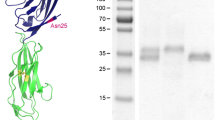Abstract
Targeting the receptor for the advanced glycation endproducts (RAGE) signalling has a potential for the prevention and treatment of several pathologies. Extracellular activation of RAGE triggers the interactions of the RAGE cytoplasmic tail with intracellular protein partners. Here the cytoplasmic tail of RAGE has been investigated by NMR as part of the full-length protein, in the presence of a membrane-mimicking environment. The isolated cytoplasmic tail has also been studied for comparison. The NMR spectra of the whole receptor show that some but not all residues belonging to the C-terminal region of the cytoplasmic tail have a large flexibility, while the membrane proximal region seems to be rigidly connected to the trans-membrane domain and ectodomains. The analysis indicates that the behavior of the cytoplasmic tail is strongly affected by its being part of the whole receptor. These results provide new insight towards the understanding of signal transduction by RAGE.



Similar content being viewed by others
References
Barbato G, Ikura M, Kay LE, Pastor RW, Bax A (1992) Backbone dynamics of calmodulin studied by 15N relaxation using inverse detected two-dimensional NMR spectroscopy: the central helix is flexible. Biochemistry 31:5269–5278
Bermel W, Bertini I, Felli IC, Lee Y-M, Luchinat C, Pierattelli R (2006) Protonless NMR experiments for sequence-specific assignment of backbone nuclei in unfolded proteins. J Am Chem Soc 128:3918–3919
Chavakis T, Bierhaus A, Nawroth PP (2004) RAGE (receptor for advanced glycation end products): a central player in the inflammatory response. Microbes Infect 6:1219–1225
Grzesiek S, Bax A, Clore GM, Gronenborn AM, Hu JS, Kaufman J, Palmer I, Stahl SJ, Wingfield PT (1996) The solution structure of HIV-1 Nef reveals an unexpected fold and permits delineation of the binding surface for the SH3 domain of Hck tyrosine protein kinase. Nat Struct Biol 3:340–345
Hudson BI, Kalea AZ, Arriero MD, Harja E, Boulanger E, D’Agati V, Schmidt AM (2008) Interaction of the RAGE cytoplasmic domain with diaphanous-1 is required for ligand-stimulated cellular migration through activation of Rac1 and Cdc42. J Biol Chem 283:34457–34468
Ishihara K, Tsutsumi K, Kawane S, Nakajima M, Kasaoka T (2003) The receptor for advanced glycation end-products (RAGE) directly binds to ERK by a D-domain-like docking site. FEBS Lett 550:107–113
Kay LE, Torchia DA, Bax A (1989) Backbone dynamics of proteins as studied by 15N inverse detected heteronuclear NMR spectroscopy: application to Staphytococcal nuclease. Biochemistry 28:8972–8979
Neeper M, Schmidt AM, Brett J, Yan SD, Wang F, Pan YC, Elliston K, Stern D, Shaw A (1992) Cloning and expression of a cell surface receptor for advanced glycosylation end products of proteins. J Biol Chem 267:14998–15004
Peng JW, Wagner G (1994) Investigation of protein motions via relaxation measurements. Methods Enzymol 239:563–596
Rai V, Maldonado AY, Burz DS, Reverdatto S, Schmidt AM, Shekhtman A (2012) Signal transduction in receptor for advanced glycation end products (RAGE). Solution structure of C-terminal rage (ctRAGE) and its binding to mDia1. J Biol Chem 287:5133–5144
Sakaguchi M, Murata H, Yamamoto K, Ono T, Sakaguchi Y, Motoyama A, Hibino T, Kataoka K, Huh N (2011) TIRAP, an adaptor protein for TLR2/4, transduces a signal from RAGE phosphorylated upon ligand binding. PLoS ONE 6(8):e23132
Sàrkàny Z, Ikonen TP, Ferreira-da-Silva F, Saraiva MJ, Svergun D, Damas AM (2011) Solution structure of the soluble receptor for advanced glycation end products (sRAGE). J Biol Chem 286:37525–37534
Schmidt AM, Yan SD, Yan SF, Stern DM (2000) The biology of the receptor for advanced glycation end products and its ligands. Biochim Biophys Acta Mol Cell Res 1498:99–111
Shen Y, Delaglio F, Cornilescu G, Bax A (2009) TALOS+: a hybrid method for predicting protein backbone torsion angles from NMR chemical shifts. J Biomol NMR 44:213–223
Sparvero LJ, Asafu-Adjei D, Kang R, Tang DL, Amin N, Im J, Rutledge R, Lin B, Amoscato AA, Zeh HJ, Lotze MT (2009) RAGE (receptor for advanced glycation endproducts), RAGE ligands, and their role in cancer and inflammation. J Trans Med 7:17
Acknowledgments
This work has been supported by MIUR-FIRB contracts RBLA032ZM7, RBRN07BMCT and RBIP06LSS2, by Ente Cassa di Risparmio di Firenze, and by the European Commission, contracts Bio-NMR n. 261863, East-NMR n. 228461, STREP–SFMET n. 201640, SPINE2-COMPLEXES 031220, and We-NMR 261572.
Author information
Authors and Affiliations
Corresponding author
Electronic supplementary material
Below is the link to the electronic supplementary material.
Rights and permissions
About this article
Cite this article
Borsi, V., Cerofolini, L., Fragai, M. et al. NMR characterization of the C-terminal tail of full-length RAGE in a membrane mimicking environment. J Biomol NMR 54, 285–290 (2012). https://doi.org/10.1007/s10858-012-9671-0
Received:
Accepted:
Published:
Issue Date:
DOI: https://doi.org/10.1007/s10858-012-9671-0




